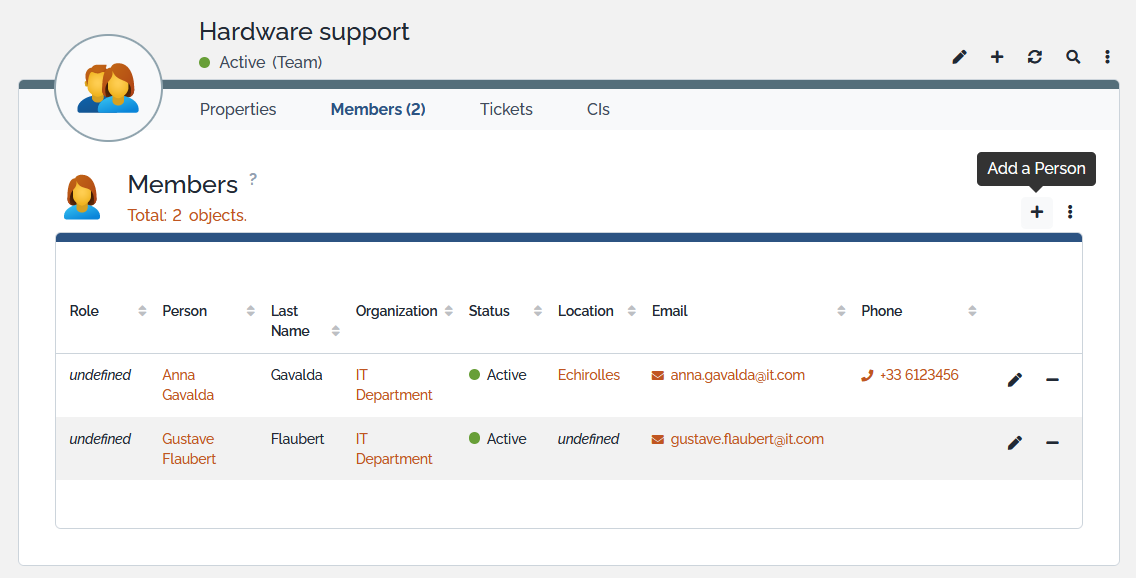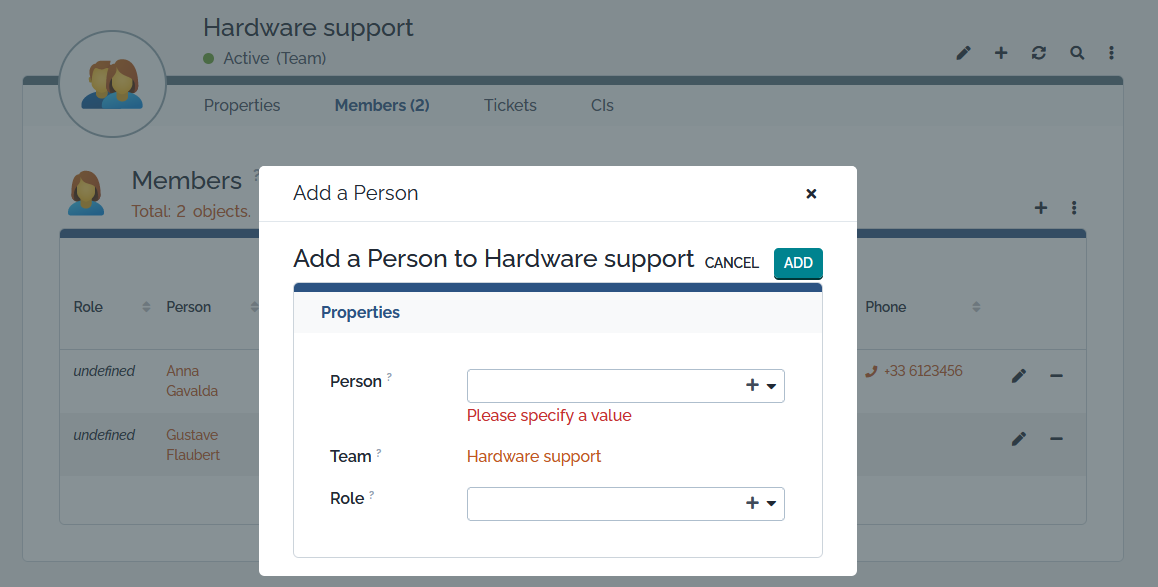What's new on iTop SaaS 3.1
- Available with
- Free
- Team
iTop 3.1
-
SaaS 3.1.0 release date: Septembre 2023
-
List of changes across iTop history: Cumulative Change Log
-
List of Known Issues in 3.1.0 version
What's new in iTop 3.1
| This version focused on improving the User Experience on the back-end iTop console |
Differentiate homonyms
Summary card
Sometimes just the name of an object is not enough to identify it clearly, in this case, leave your mouse over its name, and after a delay, more information about that object is displayed in a popup, with the possibility to directly edit that object in full screen.
Person
Multiple other classes do have a summary by default.
Complementary Name
Useful when selecting objects in a drop-down list:
Trigger (class, Additional information)
Multiple other classes do have a complementary name
Relationships
We've simplified the way to create, add, modify, remove and delete related objects, proposing those actions without editing the current object.
1:n view mode
If the user has the rights, they can add and remove sub-objects from the details view, without editing the current object it-self.
Example of a Ticket, on which one's can create, modify or delete associated Work Orders
-
create
-
modify
-
delete
As long as the user is allowed to edit and delete the Work Order, regardless if he is allowed or not to modify the User Request, the above actions will be available for him.
n:n view mode
It's now possible to add and remove related objects from the details view, without editing the current object it-self, which means that a user can do it even if he is not allowed to modify the current object, as long as he is explicitly allowed to modify the relationship or at least the remote class.
Example of a team, on which we want to:
-
add a person,
-
modify his role
-
or remove from the team
n:n like Tagset
The 3.1 iTop version brings a new way to handle many to many relationship which do not have attributes and are not expected to contain a lot of related objects.
User - Profiles
For example a User can be linked to a few Profiles, with this new capability the Profiles can be selected in the properties tab of the object, so its easier not to forget to fill them.
Limitations
-
There is still no visual indication that the relation is mandatory and not fed
-
When an object is created/modified in a pop-up screen, relations tabs are not displayed, so you can't select any Allowed organizations.
-
In 3.0.0, there is a comment field on the User to Profile relationship, which can be used to specify when and why this profile was given, it can even be the User Request reference justifying this access. But on the other hand there was no mean to comment a Profile removal.
-
It could now be done from now on in the User log.
Notification - Triggers
Other example, when creation / editing an Email Notification, you can choose the Trigger(s) directly the properties tab of the Notification
If the trigger you want does not exist yet, you can create it from here

 It will be added to the Related Triggers field after creation in pop-up.
It will be added to the Related Triggers field after creation in pop-up.
If you are not at ease with this new mode, the reverse side of the relation is still using the tab display.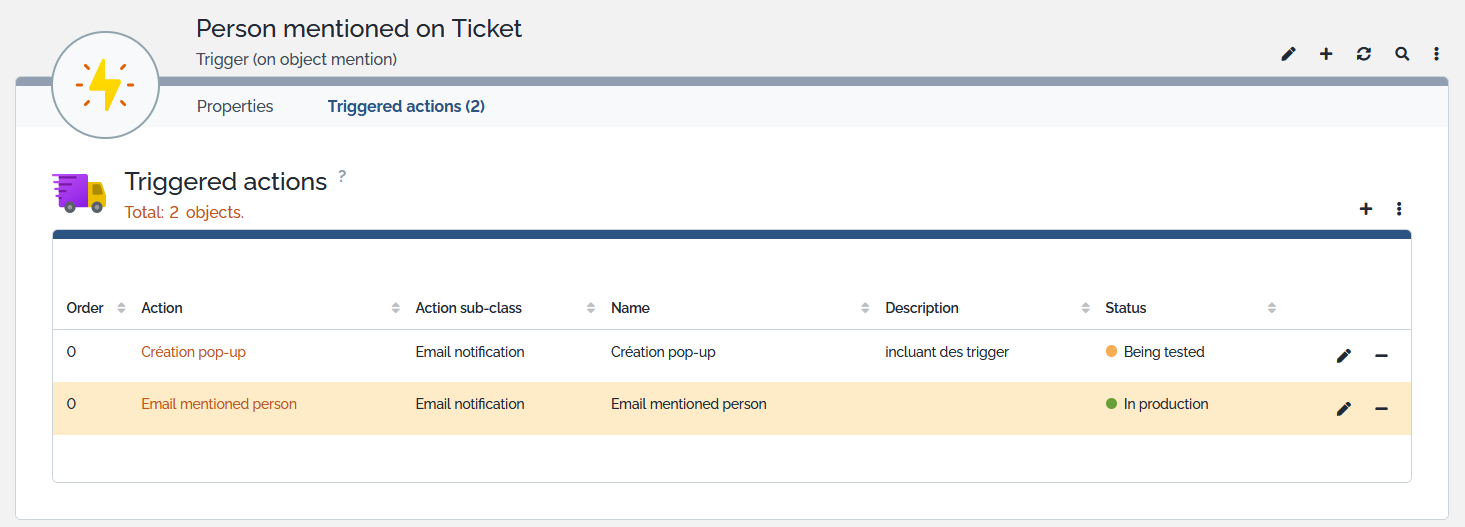
-
This other view still allow to set the order relational field.
n:n edition
The buttons have moved to the right upper corner of the list
Filter a list
Now in every list (dashlet list, object relation tab, run query result, …) you can click on
-
the list count: Total: X objects
-
or use the new action menu Display list with search criteria…
Both links will open the same query in full screen, with the corresponding search criterion set.
-
You will then be able to change the filters, to reduce the results,
-
run the menu “Configure this list” to modify the displayed fields, etc.
-
In the case of a many to many relationship tab, the query includes the link and its fields.
-
It offers bulk actions on those links and linked objects
Bulk actions on multi-classes
When a list of objects returned more than one class of object, different new actions are proposed to users having bulk-modify right on those classes. For each class, if the user is allowed it proposes
-
a bulk edit
-
a bulk delete
You can end-up in this situation in the tab of a many to many relationship displayed in the details of an object. Such list contains two classes, the Link and the Remote class.
You can also end-up in this situation with a multi-classes OQL entered in
-
a dashlet list
-
a run query
-
a shorcut
Example with a run query on 3 classes:
Datamodel changes
New layout
Person: tab User added, of course, it is only visible to users being allowed to see the User class.
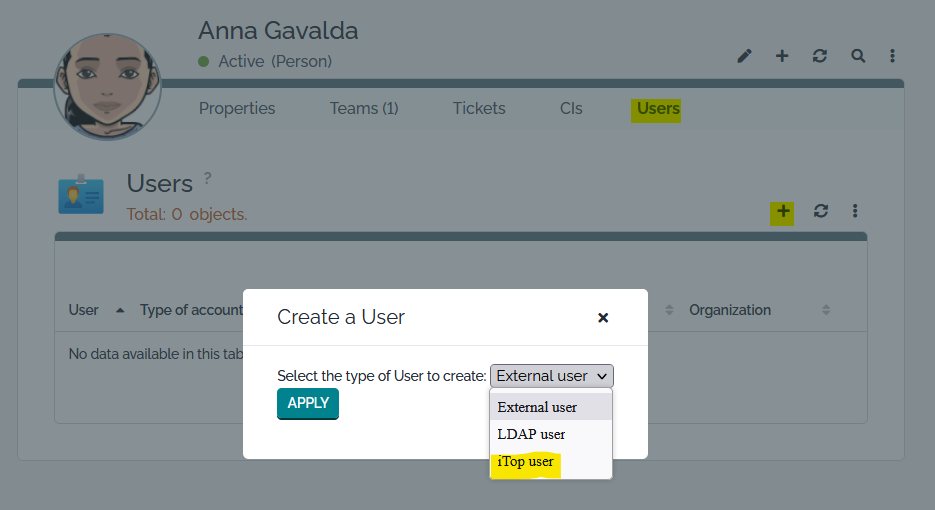
-
A Person's organization can no more be changed if it has associated “Portal user” which would not be allowed on the new organization, as it would break the user access to iTop.
Problem: new details layout
| 3.0 layout | 3.1 layout aligned to the User Request fields order and columns |
 |
 |
Customer Contract and Provider Contract: new details layout with two columns and three fiedsets
More tooltip
Notification
Notification enriched tooltips proposing usable placeholders



Menu
Menu tooltip have been restored (they disappeared in 3.0.0)
Object tabs
Tooltip are more visible and available on tab title as well
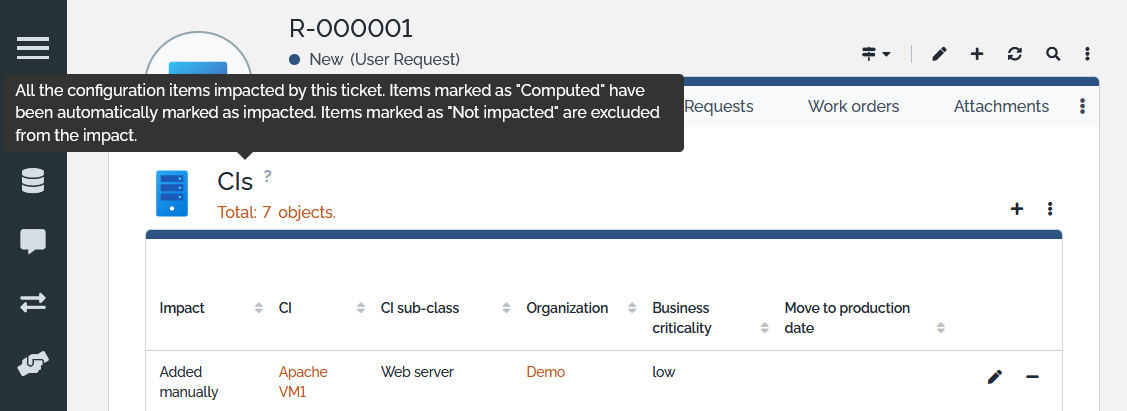
CSV import
Feedback during CSV import have been improved, when reconciliation on enumeration value or external key are failing
-
On enumeration, in case of no match, the allowed values are displayed
-
On external key, in case of no match,
-
some of the existing values are displayed and a search button is proposed to check by yourself in another window
-
if there is no entries in iTop (or no entries visible to the current user), a message will tell you:
-
There are no 'Organization' objects
-
There are no 'Organization' objects found with your current profile
-
-
Logoff
Now automatically returns on login screen
Audit
New dashboard
New dashboard to configure the audit
The improvements below are due to Combodo's historical partner Itomig. A big thanks to Lars Kaltefleiter!
Audit segmentation
Segmentation of the audit by Domain:
-
Users can check audit related to their domain only, and not be bothered by errors they are not responsible to fix
-
This improve the audit performance and even restore the audit capability on iTop which data have increased so much that audit is never ending anymore within reasonable time
-
Limit the audit calculation to what is pertinent to the user requesting it
 |
 |
-
From each audit category results, those who have enough rights, can jump with the
wenchicon on the Audit Category object, to adapt the rules if needed. -
With Hyperlinks configurator included for Combodo's customers, you can test the result of an audit domain, category or rule directly from those objects.
Configurable thresholds
Colors threshold by category
-
On each rule it is now possible to define the value of the thresholds which make the result good, poor or bad
Query Phrase
New information added to the Query Phrase to track usage of each query, so you can clean-up no more used ones
-
Total usage count
-
Last user
-
Last usage date
For administrators
Notifications
Email Notifications have been enhanced with new fields:
-
A Language field, which allow placeholders to be translated in the language specified in this field, instead of the language of the user who triggered the notification.
-
An HTML template file, which allow to send nice HTML email, without losing the possibility to contain placeholders. Note that you now have a preview.
-
An Ignore the Notify flag field. If set to “No” it automatically discard Persons with
Notificationset toNofrom the TO, CC and BCC. No need to include this logic in your OQLs anymore.
Notifications on file attribute / attachment download
A downloads counter was added to the ormDocument object (file attributes, attachments)
-
Counter starts at 0 after migration, even for existing documents that have already been downloaded in the past.
-
Display counter in attachments table (in object details).
-
Does display counter on AttributeBlob.
File attribute
A new Trigger (on object's document download) is available, it will be activated when someone downloads a file attribute (eg. File on the Document File class) in the backoffice or the end-user portal.
This trigger gives you access to new placeholders in the actions (of course the standard ones are still available):
-
$file->mime_type$Mime type of the file (eg. “image/png”) -
$file->file_name$Name of the file, as uploaded. -
$file->downloads_count$Number of time the file has been downloaded. Note that it is the count BEFORE the current download, so you can hook some checks to prevent it if a threshold is exceeded. -
$file->data$Binary content of the file -
$file->data_as_base64$Base64 encoded content of the file, can be useful for integrations with other apps
Attachment
A new Trigger (on object's attachment download) is available, it will be activated when someone downloads an attachment in the backoffice or the end-user portal.
This trigger gives you access to new placeholders in the actions (of course the standard ones are still available):
-
$attachment->xxx$Same possibilities as for$this->xxx$but with the attachment itself ($thisbeing the object it is attached to) -
$attachment->mime_type$Mime type of the file (eg. “image/png”) -
$attachment->file_name$Name of the file, as uploaded. -
$attachment->downloads_count$Number of time the file has been downloaded. Note that it is the count BEFORE the current download, so you can hook some checks to prevent it if a threshold is exceeded. -
$attachment->data$Binary content of the file -
$attachment->data_as_base64$Base64 encoded content of the file, can be useful for integrations with other apps
Be cautious with $xxx->data$ and $xxx->data_as_base64$ as their output can be huge.
You still have unanswered questions ? Ask us.
Give, get, ask…
Join our community of users to share your knowledge and good practices.










